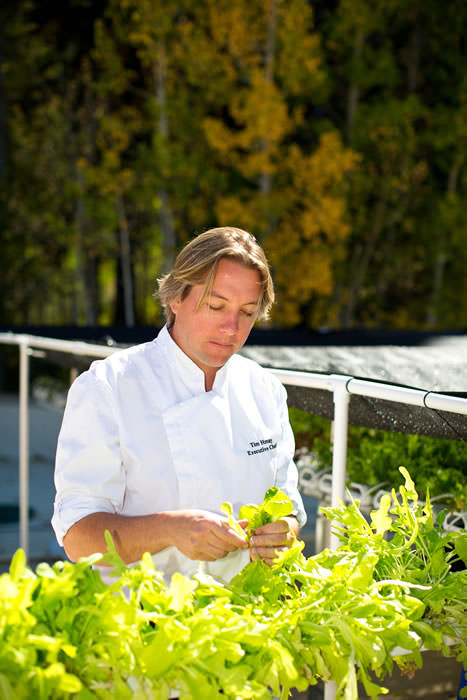edible garden
GOING GREEN GROWING GREENS
The Resort at Squaw Creek’s Rooftop Roots program makes Olympic Valley a little friendlier to the environment.
WRITTEN BY CHRISTINA NELLEMANN
PHOTOS BY GINA MUNDA
At first bite, guests at the Resort at Squaw Creek might not realize that their dinner salads came from a rooftop several yards away from their tables. However, the resort’s managing director, André Priemer, and his staff will remedy that with ebullient education on the resort’s garden programs.
This is the third year of the resort’s Rooftop Roots program that actually encompasses three areas of the property at the base of Squaw Valley Ski Resort. The Rooftop Roots garden is located on a roof near the deluxe guest rooms, a seedling and microgreens garden is located near the Mountain Buddies children’s program area, and several hydroponic growing towers have been placed in the multistory lobby.
Microgreens are germinated seeds whose entire root, seed, and shoot are eaten. Many types of seeds can be grown as microgreens, including pea shoots, cilantro, arugula, and mustard greens. Six Peaks Grille’s executive chef Tim Hmay adds the microgreens to various salads and entrées.
The lobby’s growing towers feature various salad greens and berries harvested for dishes served at the restaurant. Herbs such as parsley, basil, and thyme are used as garnish for the restaurant’s Garden to Glass cocktails. Even in the middle of winter, the growing towers are dotted with bright red strawberries, delighting guests who tour the lobby.
“The purpose of these towers is to provide fresh produce, and they also act as a food demonstration center,” says Smitty Smith, the resort’s full-time gardener. “This way, you can see how to create fresh food in your own garden.”
“We wanted to showcase what we are doing, get the conversation going with our guests, and really spark interest in the program,” Priemer says. “We wanted to show that you can grow whatever you like in a very small place while having a connection with your environment.”
Viable vegetables
This summer, the resort meets its goal to be completely self-sustainable with its supply of salad and herb plants. With more than 3,600 plants growing in the gardens, the resort even has enough to donate part of its produce to the local school system through the Tahoe Food Hub, a nonprofit organization that works with small farm owners to build a sustainable and regional food system for North Lake Tahoe.
“The Rooftop Roots program started with the idea of becoming more self-sustainable,” Priemer says. “We used to get most of our salad greens and herbs from 100 to 200 miles away, and we knew we could grow our own here. As a large business, we have the responsibility to reduce our carbon footprint and ensure that we make a meaningful impact on the environment.”
The rows of plants on the resort’s roof include various salad items such as butter lettuce and mesclun mix. Tomatoes, squash, cucumbers, and peppers, as well as more herbs also are part of the summer plan. Because of Tahoe’s short growing season, fruits in general don’t do as well on the roof.
Three years ago, when Rooftop Roots was put into effect, the harsh, high-altitude sun reflecting off the white surface actually burned the leaves on many of the plants. The next year, the staff covered the plants with dark shade cloth that needed to be strapped down against the high winds that could whip through the valley. But the area’s early frosts actually are welcomed for plants such as kale, which takes on a sweeter flavor in colder weather.
The next evolution for the program is to add beehives to the resort property to help pollinate the crops while adding local honey to the restaurant’s dishes. Plans also include the addition of garden education to the resort’s children’s program.
“We are not going to limit ourselves to herbs and salads,” Priemer says. “We really want to push the boundary to see how far we can take it.”
Both resort guests and visitors soon will have a chance to learn more about the program with guided tours around the Rooftop Roots garden. The small community of Olympic Valley also is curious about the gardens and questions the staff about the amount of work the program entails.
“They are amazed at what you can accomplish when you put some love and effort into it,” Priemer says.
Christina Nellemann is a writer living in Washoe Valley. She thoroughly enjoyed a fresh, tangy salad from the resort’s Rooftop Roots garden.
Resources
For details, visit Destinationhotels.com/squawcreek
Recipe
Six Peaks Grille Rooftop Mizuna Pesto
(courtesy of Tim Hmay, executive chef, Resort at Squaw Creek in Olympic Valley, Calif. Makes 1 quart)
Mizuna is a mild-tasting member of the mustard family. As an Asian green, it can be used in both raw and cooked dishes. In Hmay’s fragrant recipe, it’s used in place of basil.
2 cups mizuna
2 tablespoons minced garlic
¼ cup pistachio nuts
½ cup extra-virgin olive oil
¼ cup Parmesan cheese, shredded
¼ cup Asiago cheese, shredded
1 teaspoon Meyer lemon zest
Juice from ½ Meyer lemon
Salt and pepper, to taste
In a food processor, add mizuna, garlic, and pistachios, and pulse quickly until all ingredients are chopped roughly. Reserve in mixing bowl.
In separate bowl, mix olive oil, Meyer lemon zest, and juice. Slowly add oil-and-lemon mixture into first bowl until desired consistency is reached. Fold in shredded cheese and salt and pepper to finish.


